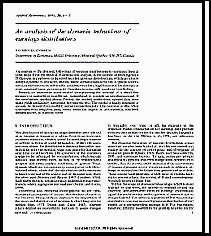Published in Applied Economics, Vol 30, pp 1-17 (1998)
An Analysis of the Dynamic
Behaviour of Earnings Distributions

Ruben
D. Cohen (email)
Abstract
An Analysis of the dynamic behaviour of earnings
distributions is conducted here in three ways.
First, the method of dimensional analysis, in the context of
Buckingham’s P theorem, is employed
to demonstrate that earnings distributions, which are almost always dynamic in
character, should, under certain conditions and a special coordinate
transformation, be self-similar and time-invariant. Application of the theorem to some empirical data, pertaining to
Canadian income, fully confirms this finding.
Second, an economics-based model, incorporating the concept
of a shock-free economy in competitive equilibrium, is developed to provide an
intuitive account of the conclusions reached above. Testing the model’s predictions against data once again yields
satisfactory agreement between the two.
The
model is finally extended to account for
labour-force mobility across income brackets. The outcome of this, when compared with empirical data, could
reflect the degree of homogeneity, and even discrimination, in a labour force.